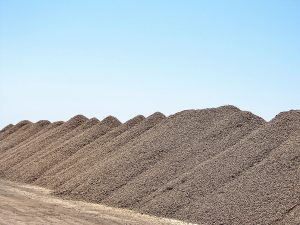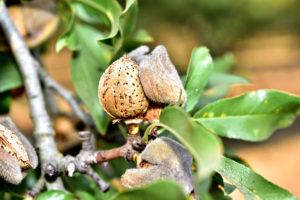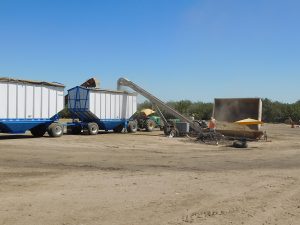
Director, Member Relations
This report covers conditions and observations made between Monday, August 1 and Sunday, September 4, 2016.
Northern Region – Growers in the Sacramento Valley enjoyed slightly cooler conditions than those in the San Joaquin during August. However, temperatures were still more than adequate to propel the crop towards harvest. While daily maximum temperatures reached to or above 100 degrees on several days during the period, the vast majority of readings were reported in the lower 80’s to low and middle 90’s. Meanwhile, morning low temperatures were widely reported between the lower 50’s to lower 60’s throughout the period.
Harvest operations in the northern region are progressing at what some have referred to as a “record pace”. Observers along the west side of the region have reported that shakers, sweepers and harvesters have moved quickly through the Nonpareil variety, with approximately 90% of the acreage already out of the fields and delivered to huller/sheller operations throughout the region. After a slight pause to irrigate, machinery has been sent back into the orchards to begin the harvest of the various pollenizer varieties, with all but the late harvesting Fritz now being shaken. Meanwhile, growers in the region’s northern areas have reported a slightly slower pace of activity, with moisture and humidity levels reportedly slowing the drying process in the fields as well as the pace of hulling and shelling.
Growers have been reporting that Nonpareil yields are running, on average, below last year’s levels. Some have noted that rapid progression of the 2016 bloom, coupled with drying north winds as the possible reason for the lower production levels. A significant number of growers have reported yields from 10% to 20% below 2015 levels, with the greatest reductions reported as high as 30%. Fortunately, reject levels are running below last year, a year when Navel Orange Worm caused significant losses after drought conditions reduced grower’s ability to reduce overwintering insect populations. Wetter conditions this past winter helped grower reduce the overwintering population, an important aid in holding damage to more tolerable levels.
Some growers are fighting increasing populations of web-spinning mites, which, when combined with infections of Scab and Rust have caused some degree of defoliation. While late in the season, excessive defoliation can reduce tree vigor and potentially impact the 2017 crop in the most severe cases.
Central Region – Seasonably warm temperatures dominated the weather in the central region during August, providing good conditions for the 2016 harvest. Daily maximum temperatures ranged from the lower 90’s to just over 100 degrees for the majority of the period, with more mild readings in the lower 80’s to lower 90’s reported in the final week of the period. Morning lows reflected the daily highs, with readings widely reported between the mid 50’s and lower 60’s.
Harvest operations have progressed smoothly and rapidly throughout the central region, allowing many to complete harvesting the Nonpareil with no difficulty. While the majority have paused to irrigate their orchards after picking up the Nonpareil, advanced maturity in many plantings has inspired a number of growers to forego an irrigation and immediately shake the next variety. Consequently, some growers have completed their harvest and are now irrigating. Huller/sheller operations are processing crop receipts quickly, However, stockpiles of Nonpareil can be found at sheller facilities waiting to be shelled as growers turn their attention to the balance of their varieties. As previously noted, pollenizer varieties are maturing quickly and as this report is being prepared, the first Monterey plantings have already been shaken. Some are anticipating that the most advanced Fritz plantings along the west side of the region will be shaken within the next week. As expected, yield levels of the Nonpareil are running generally stronger than reported in the 2015.
Observers are reporting that the number of orchards impacted by web-spinning mites has increased in recent weeks, with the most serious infestations defoliating trees in all areas of the region. Growers are generally powerless to control these populations at this point in the growing season and must endure the increasing damage. In some cases, the level of defoliation is exacerbated by infections of Scab and/or Rust. While reject levels are running lower than last year, some growers are still reporting higher than desired damage levels. Some believe that the heat waves experienced during July complicated the timing of hull split treatments for Navel Orange Worm, reducing effectiveness and creating additional opportunities for damage.
Southern Region – Hot, dry conditions reigned over the southern San Joaquin Valley during August, driving the maturing crop towards harvest. Daytime temperatures were consistently reported between the lower 90’s to just over 100 degrees throughout the period, with mildest temperatures reported in the period’s final week. Morning lows were fairly static during the month, with readings widely reported between the mid 50’s to mid and upper 60’s.
Observers are reporting that the 2016 harvest is progressing quite rapidly in the southern San Joaquin. Shakers are moving quickly from orchard to orchard in rapid succession and nearly all of the Nonpareil has been shaken as this report was being prepared. Growers with Price and Sonora varieties have been faced with a decision to immediately shake their pollinizers and risk drying out the orchard, or irrigating after picking up the Nonpareil and risk further exposure to Navel Orange Worm. In any event, growers are now focusing their attention on the pollenizer varieties with some reporting that the only restriction is the availability of equipment to complete the work. Observers are reporting that all varieties are now being shaken, with the exception of the traditionally last-to-harvest Fritz, which many are expecting to starting shaking within the coming week. Stockpiles of Nonpareil are building at shellers around the region. These piles will be run later in the season as soon as harvest operations have been completed in the orchards. Growers are reporting that yields of the Nonpareil are running ahead of last year’s level, as was expected.
Populations of web-spinning mites, noted in previous reports have increased under the influence the hot temperatures. Observers are reporting that a considerable number of orchards throughout the southern region have experienced damaging populations and significant amount of defoliation. Growers are hopeful that the reduced temperatures experienced in the closing days of the period, along with increasing morning dew will help to slow mite development enough to allow predators to regain some measure of effectiveness. Observers have also noted variable levels of damage by Navel Orange Worm. While damage is on average running below last year’s levels, some growers are experiencing elevated damage levels, while other are reporting few difficulties.
Over coming weeks, growers will rush to bring in the crop as quickly and as efficiently as possible, hoping to avoid any rain that may pass over the valley.
The next scheduled report will be posted on Monday, October 3, 2016. In the event of any significant occurrences prior to that date, this site will be updated as soon as possible.


